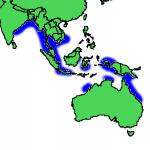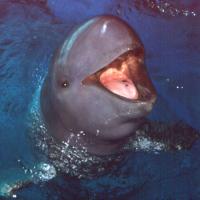 |
 Distribution Map
Distribution Map(Click for larger version) |
Irrawaddy Dolphin
|
 An Irrawaddy Dolphin
An Irrawaddy Dolphin
From the NUS Dolphin Study Group Etienne Douaze <douaze@dsg.sbs.nus.edu.sg Permission obtained on 30 July 1998, Email message. |
The Irrawaddy dolphin, sometimes classified in the family Monodontidae with belugas and narwhals, is found in south and southeast Asia, from the Bay of Bengal, throughout the Indo-Malay Archipelago, to northern Australia. Its favorite habitats appear to be the warm shallows and the major rivers, such as the Ganges, the Mekong, and the Irrawaddy. Unfortunately, the habitat where it is found is very vulnerable. Barrages near the mouth of the Ganges cut off the population above the dams and possibly elimite it entirely. As there are relatively few reports, it does not appear to be very common in its range. However, it is very unobtrusive and difficult to observe in the wild. On the dorsal side, it varies from grayish blue to black, while it is lighter on the ventral side. It does not have a beak, but some descriptions do show a slight protuberance near the mouth. The Irrawaddy dolphin is small, with a maximum length of only 2.1 meters. The neck is unusually flexible, as only the first and second vertebrae are fused. The dorsal fin is far behind the body's midline and small, sometimes only reaching a height of two centimeters. There are well-developed caudal keels on the tail stock. The blowhole is somewhat more on the left side of the body than the right. Groups consist of three to six individuals. Irrawaddy dolphins exhibit rather peculiar behavior in the wild, as they swim with a rolling motion near the water's surface, with their heads halfway in the air. Sometimes they come fully out of the water and spew a large amount of water from their mouths. They have also been seen standing upright in the water with one half of the pectoral fins are exposed, making the dolphin look like it is standing on its flippers.
|
|
|
|
|
![]()
Bibliography
Baker, Mary L. Whales, Dolphins, and Porpoises of the World. New York: Doubleday & Company, Inc., 1987.
Carwardine, Mark. Eyewitness Handbooks: Whales, Dolphins, and Porpoises. New York: Dorling Kindersley Ltd., 1995.
Ellis, Richard. Dolphins and Porpoises. New York: Alfred & Knopf, Inc., 1982.
Klinowska, Margaret. Dolphins, Porpoises, and Whales of the World: The IUCN Red Data Book. Gland, Switzerland: World Conservation Union, 1991.
|
© 1998 Thinkquest Team 17963 <17963@advanced.org Modified: 29 August 1998, Created: 14 August 1998 |
